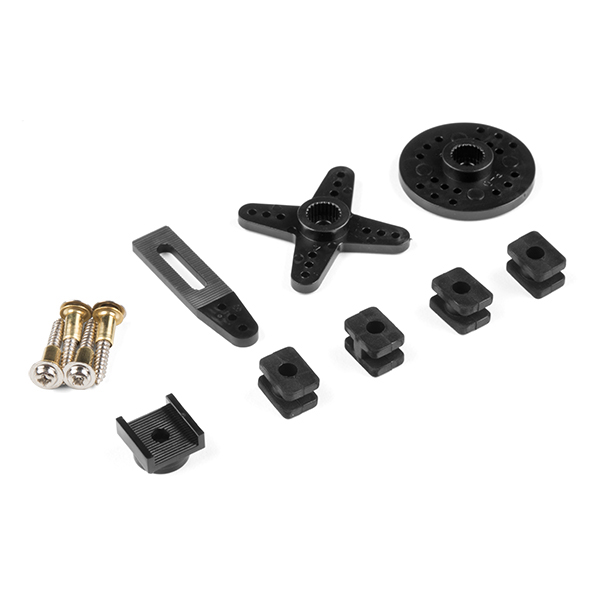This is the classic Hitec HS-422 servo. This solid consumer grade servo is able to take in 6 volts and deliver 57 oz-in. of maximum torque at 0.16 sec/60°, this is a simple servo for any beginner project!
This high quality servo is perfect for your mechatronic needs and if you are looking to get into robotics, this is where to start. The HS-422 servo comes standard with a 3-pin power and control cable and all hardware listed below.
- 1x HS-422 Servo
- 1x Circle Horn
- 1x Double Arm Horn
- 1x Single Arm (w/ Slide Bracket) Horn
- 1x Four Point Horn
- 4x Rubber Grommets
- 4x 2x15mm Phillips Screw
- 4x Brass Eyelets
- Voltage: 4.8-6.0 Volts
- Torque: 45.82/56.93 oz-in. (4.8/6.0V)
- Speed: 0.21/0.16 sec/60° (4.8/6.0V)
- Direction: Clockwise/ Pulse Traveling 1500-1900usec
- Rotation: 180°
- Dual Oilite Bushing
- Nylon Gears
- 3-Pole Ferrite Motor
- C1 Standard Spline* 40.6 x 19.8 x 36.6mm
- Wire Length: 300mm
- Weight: 45.5g
Servo - Hitec HS-422 (Standard Size) Product Help and Resources
Servo Trigger Hookup Guide
March 26, 2015
How to use the SparkFun Servo Trigger to control a vast array of Servo Motors, without any programming!
Hobby Servo Tutorial
May 26, 2016
Servos are motors that allow you to accurately control the rotation of the output shaft, opening up all kinds of possibilities for robotics and other projects.
Papa Soundie Audio Player Hookup Guide
April 26, 2018
Add sound effects to your project, prop or costume with Papa Soundie Audio Player.
Resources and Going Further
Check out this project using the thermocouple and Hitec servo to control the the temperature of a reflow toaster oven.
Core Skill: Robotics
This skill concerns mechanical and robotics knowledge. You may need to know how mechanical parts interact, how motors work, or how to use motor drivers and controllers.
Skill Level: Competent - You may need an understanding of servo motors and how to drive them. Additionally, you may need some fundamental understanding of motor controllers.
See all skill levels
Core Skill: DIY
Whether it's for assembling a kit, hacking an enclosure, or creating your own parts; the DIY skill is all about knowing how to use tools and the techniques associated with them.
Skill Level: Noob - Basic assembly is required. You may need to provide your own basic tools like a screwdriver, hammer or scissors. Power tools or custom parts are not required. Instructions will be included and easy to follow. Sewing may be required, but only with included patterns.
See all skill levels
Core Skill: Electrical Prototyping
If it requires power, you need to know how much, what all the pins do, and how to hook it up. You may need to reference datasheets, schematics, and know the ins and outs of electronics.
Skill Level: Competent - You will be required to reference a datasheet or schematic to know how to use a component. Your knowledge of a datasheet will only require basic features like power requirements, pinouts, or communications type. Also, you may need a power supply that?s greater than 12V or more than 1A worth of current.
See all skill levels
Comments
Looking for answers to technical questions?
We welcome your comments and suggestions below. However, if you are looking for solutions to technical questions please see our Technical Assistance page.
Customer Reviews
5 out of 5
Based on 1 ratings:



Are you sure this has 180 degrees rotation? From the datasheet, it sounds like only 45 degrees. Or dies "operating angle" mean something else?
This is actually something that appears to be oft-discussed in hobbby RC forums. Just as a summary: These are hobby devices with varying amounts of error (i.e. you'll always want to send pulses and get the actual angles and compensate in code accordingly). The 45 degrees refers to a single direction. This implies that it has a 90° range if you take both directions. However, that's is assumed to just be what the manufacturer is willing to state as being the range that they'll 'guarantee'; in practice many have found the range to be 180° .. or nearly that (e.g. 178°). And if that makes you think "ugh.. then how am I supposed to figure out what the actual range is?", it looks like you could form a club with similarly frustrated people :) Your best bet seems to be to google the part and check people's actual findings (keeping in mind that yours may vary somewhat).